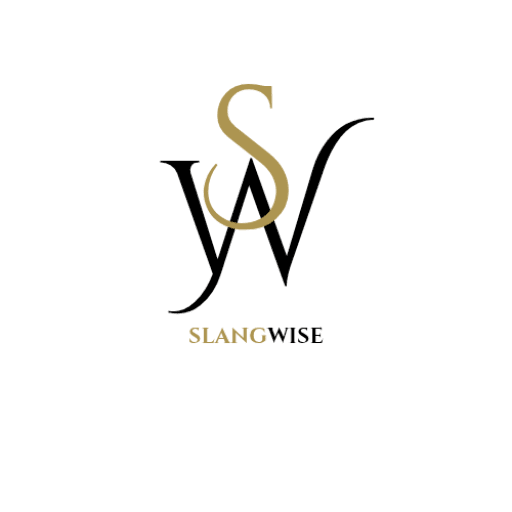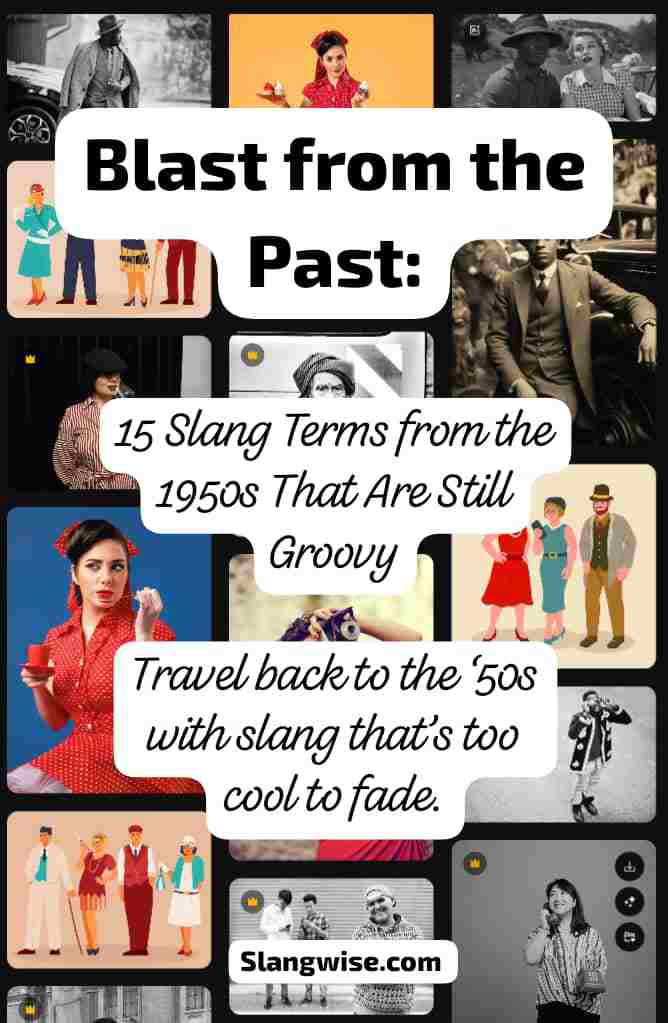Slang words from the 1950s is a short trip to a time of jukeboxes, drive-ins, and sock hops. Old words did practical work then: they labeled a person, set a mood, or signaled who belonged to which crowd.
Forget “on fleek” and “slay”, the original architects of cool had a secret language all their own. Long before the internet invented viral phrases, the 1950s forged a goldmine of slang in the real-world crucibles of sock hops, soda fountains, and drive-in theaters.
This wasn’t just vocabulary; it was a vibe. It was the smooth sound of a jazz cat’s approval, the effortless swagger of a greaser’s compliment, and the sharp wit of a teenager who was “in the know.”
These words were so sharp, so inherently hip, that they’ve refused to be relegated to the history books. They are more than just a blast from the past; they’re linguistic survivors.
They’ve dodged the dustbin of history by embedding themselves in our classic films, oldies songs, and the stories of our grandparents, waiting for the right moment to add a dash of authentic, retro flair to a modern conversation.
So, get ready to flip your lid and dig the sounds of a truly solid era. Here are 25 slang terms from the 1950s that are, and always will be, totally groovy.
Table of Contents
25 Popular Slang Words From the 50s
1. Daddy-O
Daddy-O carries the easy swagger of a jazz club or a neon-lit corner. Call someone “Daddy-O” when tipping the hat to their coolness or reliability: “Alright, Daddy-O, you got the tickets?”
It sounds warm and a little cocky at once, like telling a friend they’ve handled the plan without fuss. Today it works as a playful nod to the past; use it with friends who appreciate that wink.
2. Cool Cat
Cool cat is simple and smooth, someone who moves like music and looks like it, too. Say “He’s a cool cat” to praise someone’s calm, confident style: “She stepped into the room like a cool cat and everything slowed down.”
It also fits casual compliments now: tag a photo with “cool cat” to mean stylish or relaxed without sounding stiff.
3. Greaser
Greaser names a whole look and attitude: leather jacket, slicked hair, engine noise and a bit of edge. Saying “Those greasers parked by the diner” paints a picture fast.
The word can describe a fashion vibe in writing or a character in a story: “He rode up on a motorcycle, all greaser attitude and cigarette ash,” and the reader sees the scene.
4. Pad
Pad means a living place, almost always casual: an apartment or a little house where friends met. “Meet me at my pad after the movie” was a simple invitation. Today it still reads as laid-back: use it to add retro charm to an invite or to nickname a small, cozy home.
5. Cruisin
Cruisin’ is the slow, show-off drive of teenagers who wanted to be seen. “Cruisin’ Main Street in a Chevy” implies checking out people, music playing, and engines purring.
In modern speech, it works for any relaxed drive or for metaphorical use: “She’s cruisin’ through her exams,” meaning moving calmly through something.
6. Ankle-snap
Ankle-snap is a 1950s slang that means a quick, surprising move; something abrupt enough to catch attention, often in dance or motion. “That twist had an ankle-snap that made everyone laugh” gives the bit of comic surprise.
Use it to describe sharp dance steps, sudden physical stunts, or a move in a story that draws a startled reaction.
7. Beat Feet
Beat feet is a lively way to say “leave fast.” When trouble appears, a character might “beat feet out of the alley.” Its rhythm gives urgency without swear words. It still feels playful and works well in storytelling where pacing matters.
8. Make the Scene
Make the scene is less about arriving and more about arriving stylishly. “She knew how to make the scene, showing up like she belonged.” It describes presence — the kind of entrance that turns heads.
The phrase can elevate an ordinary arrival into something dramatic: use it when a character or friend wants to be noticed.
9. Dreamboat
Dreamboat is old-fashioned and flirtatious: someone dreamy and attractive in a gentle way. “He was a dreamboat in that suit” reads as affectionate and slightly nostalgic. In a caption or romantic line, it works as a softer compliment than modern slang might offer.
10. Thread
Threads in 1950s refers to clothes and how sharp someone looks in them. “Nice threads” meant approval for a good outfit. Use it now to point out a retro or striking wardrobe choice: “Those threads would make any character stand out on the street.”
11. Hep and hep cat
Hep and hep cat come from jazz talk and name people who know what’s happening in music and style. Calling someone hep is saying they are in-the-know: “Only a hep cat would get that new record.” It’s a vintage badge of cultural smarts, and it still reads as clever when used sparingly.
12. Bop
Bop points to music and dancing, and to a good time. “They bopped all night at the sock hop” means they danced to the beat and enjoyed themselves. The word can be used for modern parties or for describing music that makes people move: “This tune makes you bop.”
13. Flip your lid
Flip your lid is a colorful way to show extreme reaction, surprise, anger, or excitement. “Fans flipped their lids when the band hit the chorus” shows mass excitement. It’s a fun, slightly dramatic phrase that fits storytelling or a punchy description.
14. Solid
Solid means dependable, good quality, or honest. Saying “That plan is solid” gives quick approval and trust. In the 1950s, calling a person solid gave them instant respect; in writing, it still does the job of shorthand admiration.
15. Square
Square was an insult for someone uncool or stuck in old ways. “Don’t be a square” urged people to join the fun. The word helps draw sharp cultural contrasts in stories: use it to show generational difference or to tease a character’s conservative choices.
16. Sock Hop
Sock hop in 1950 slang names a school dance where kids in their best casuals jumped to the jukebox beat without shoes on the gym floor. “The sock hop had bunting, soda pops, and lots of jitterbugs.”
Mentioning a sock hop sets a scene quickly and warmly; it’s perfect for nostalgic copy or a story chapter opener.
17. Jitterbugged
Jitterbug is a fast, bouncy dance that carried excitement and athletic moves. “They jitterbugged until their feet ached” sends an image of joyous motion. Use it when a scene needs high-energy movement, or describe someone’s restless excitement as “doing a jitterbug” in a joking way.
18. Cat’s Pajamas
Cat’s pajamas is a bright compliment that means someone or something is excellent. “Her outfit was the cat’s pajamas” sounds playful and proud. It’s lighter than modern hype words and works well when the tone should be charming and old-timey.
19. Doll
Doll was a term of affection for a young woman; soft, sweet, and often romantic. “Hey, doll, want to dance?” places the speaker in a cheeky, flirtatious role. Use it carefully: it reads as nostalgic and affectionate, but context matters today.
READ ALSO: 25 Popular 90s Slang Words That Defined a Decade
20. Swell
Swell is a small, friendly superlative: great, excellent, or pleasing. “That soda was swell” is modest praise compared to louder modern terms, and it gives a gentle, upbeat voice to narration or dialogue.
21. Keen
Keen connotes enthusiasm and approval; someone keen is eager and hip. “She was keen on the new record” means genuinely into it. Place the word where earnest interest or youthful eagerness should come through without irony.
22. Gone Steady
Gone steady is the old way of saying two people were officially dating; a public pairing with rules about others. “They went steady, wearing matching class rings” implies exclusivity and teenage romance. For fiction or nostalgic pieces, it carries a clear picture of middle-class courting rituals.
23. Made in the Shade
Made in the shade is a 9150s catchphrase that means life is easy for someone in a good position. “With that job and that landlord, he was made in the shade” signals comfort and luck. The phrase still makes a fine figurative turn when describing a fortunate circumstance.
24. Rockabilly
Rockabilly names the raw, early rock ’n’ roll sound that mixed country and rhythm-and-blues; it also described the youthful style aligned with that music.
“The band played rockabilly and the whole place lit up” signals a specific musical energy and fashion. Using the term anchors any music scene to that distinct, rebellious sound.
Jive covers slick talk, trickery, or just upbeat music and dancing, depending on tone. “He gave jive about his job” suggests smooth but unreliable words. It can be playful or cautionary, useful when showing a character’s charm or their tendency to bluff.
25. Swellhead
Swellhead may not be as kind: it means someone who is full of themselves. “Don’t be a swellhead just because of one hit” warns against arrogance. It’s a compact way to call out pride in a story without resorting to harsher language.
Why These Terms Still Rock
- Iconic Media: Movies like Rebel Without a Cause and songs by Elvis Presley immortalized many of these words.
- Cultural Nostalgia: Retro diners and jukeboxes keep the 1950s alive in pop culture.
- Musical Roots: Jazz and early rock ’n’ roll continue to influence today’s artists.
- Linguistic Simplicity: Short, punchy syllables make these words easy to remember and fun to say.
Bringing ’50s Slang into Today’s World
- Text Messages & Social Media: Caption a photo with “Cruisin’” or “Cool cat” to add retro flair.
- Events & Parties: Host a ’50s-themed gathering—encourage guests to talk like “Daddy-Os” and “dreamboats.”
- Writing & Storytelling: Use one or two terms to color historical fiction or memoir.
- Fashion & Marketing: Brands can label products “solid” or “threads” to tap into vintage cool.
Final Thought
Slang is more than playful talk, it’s a mirror reflecting social change, music trends, and the rebellious spirit of youth. By weaving these 15 groovy terms into modern speech, readers connect with a bygone era while keeping language vibrant.
Whether at a diner, a dance, or online, dropping a “flip your lid” or calling a friend “Daddy-O” is a fun nod to the past, and proof that some words truly are too cool to fade.

